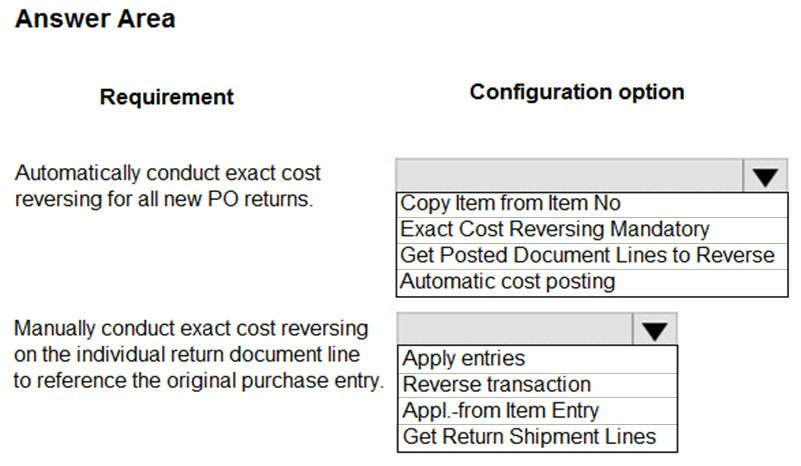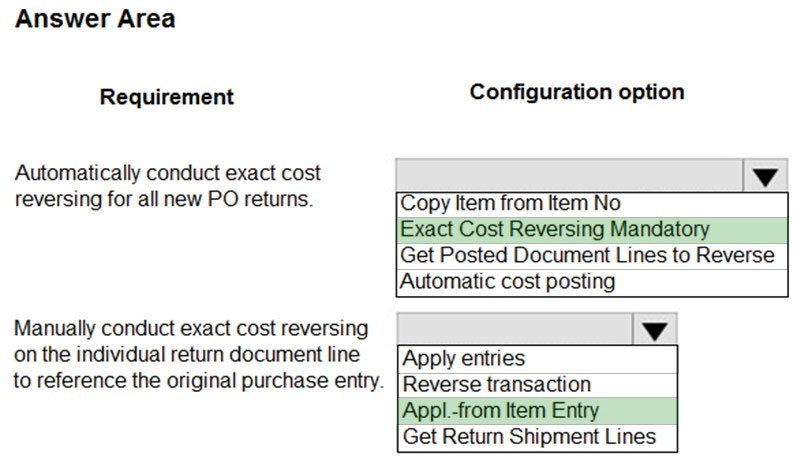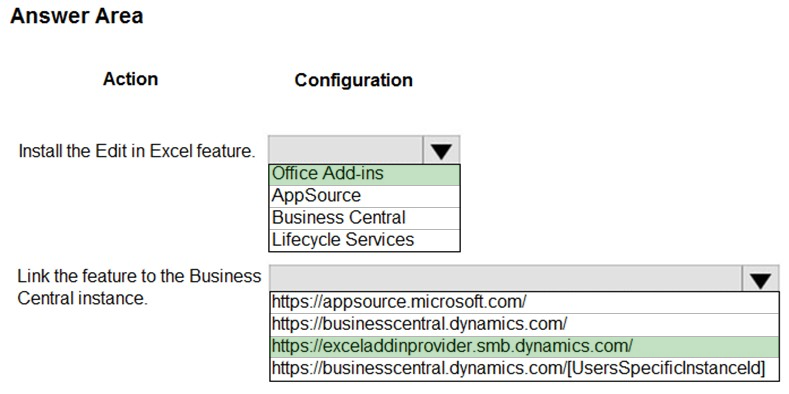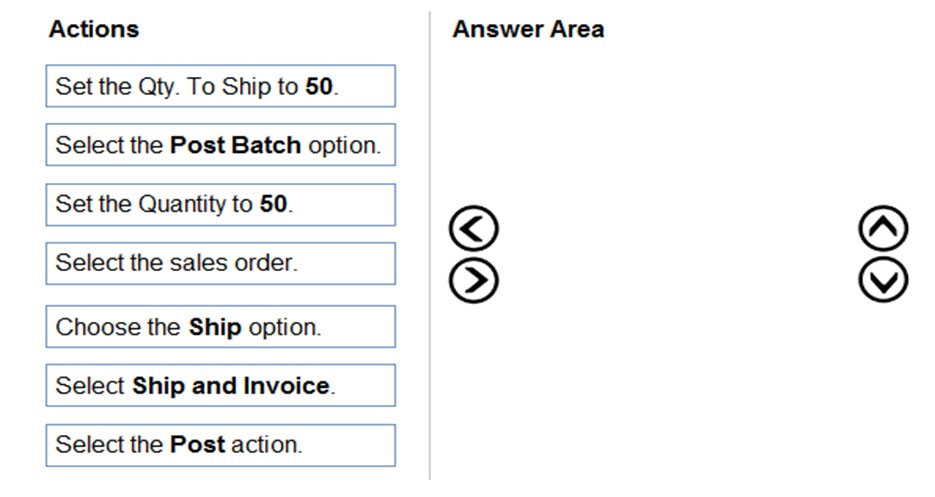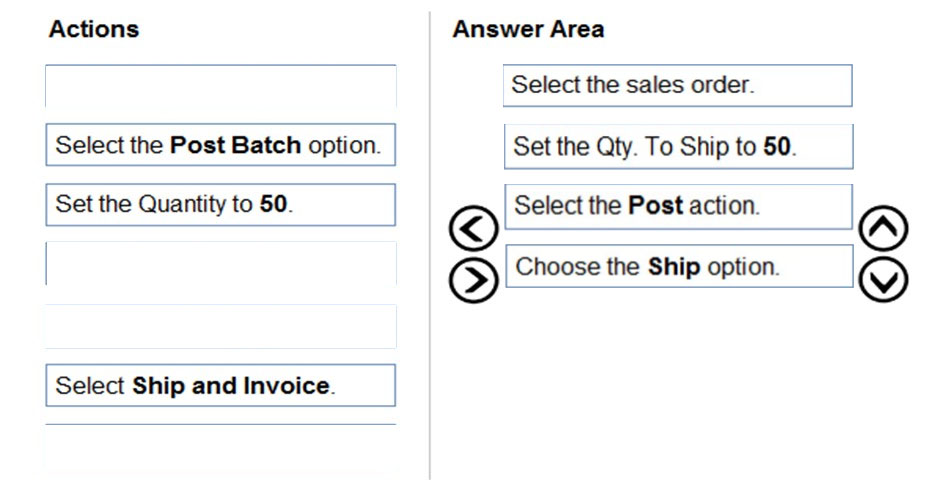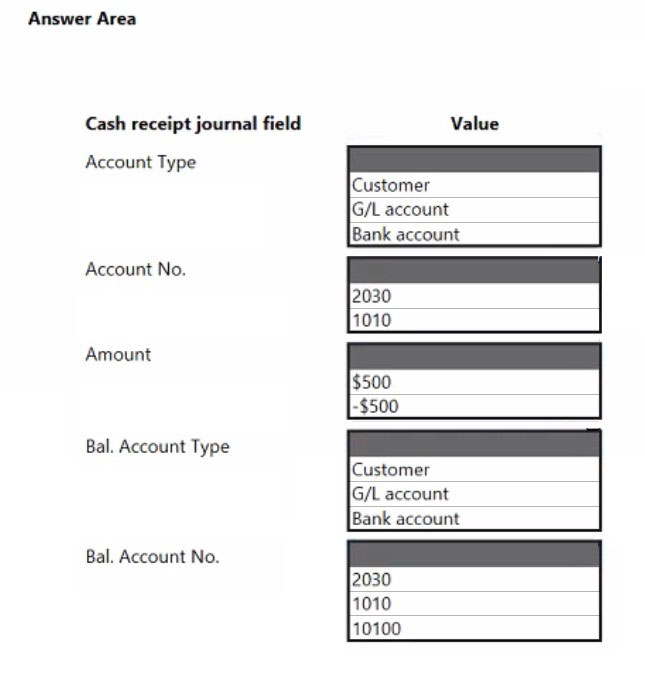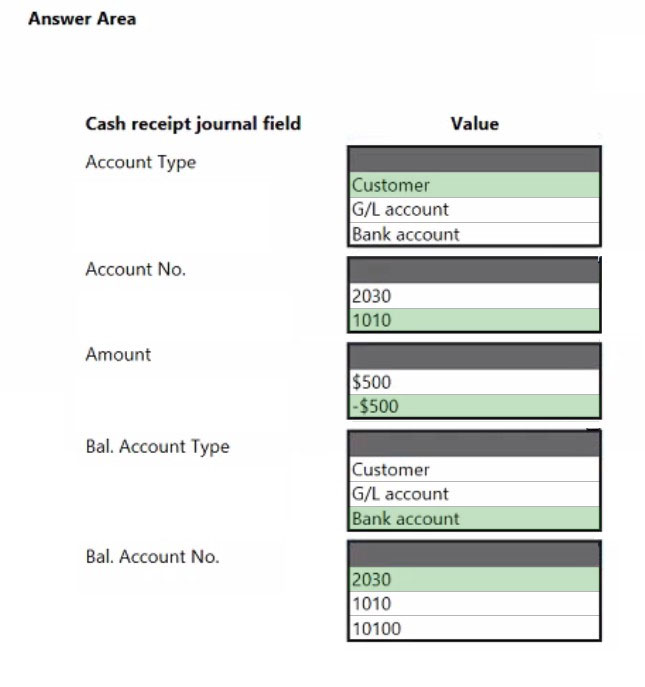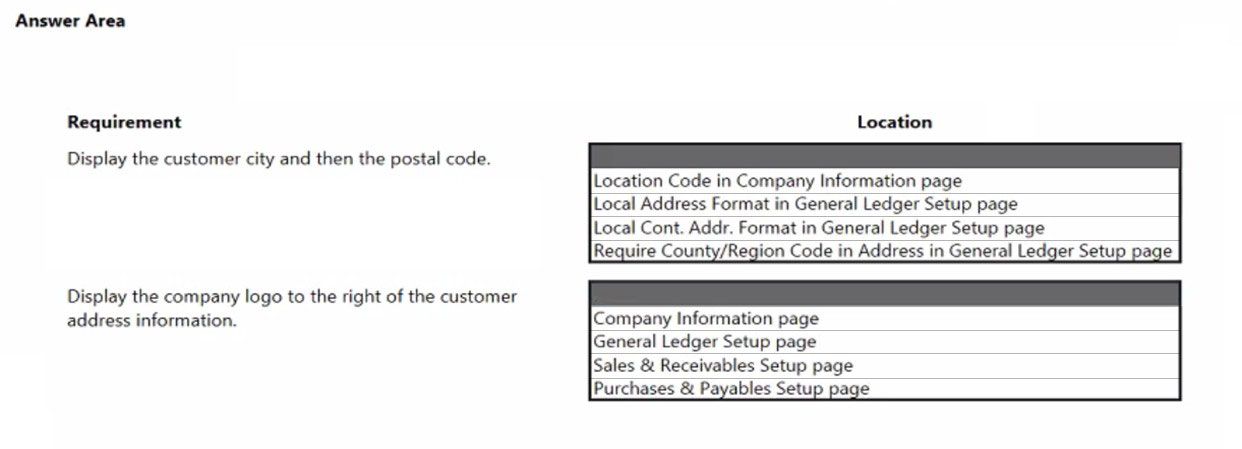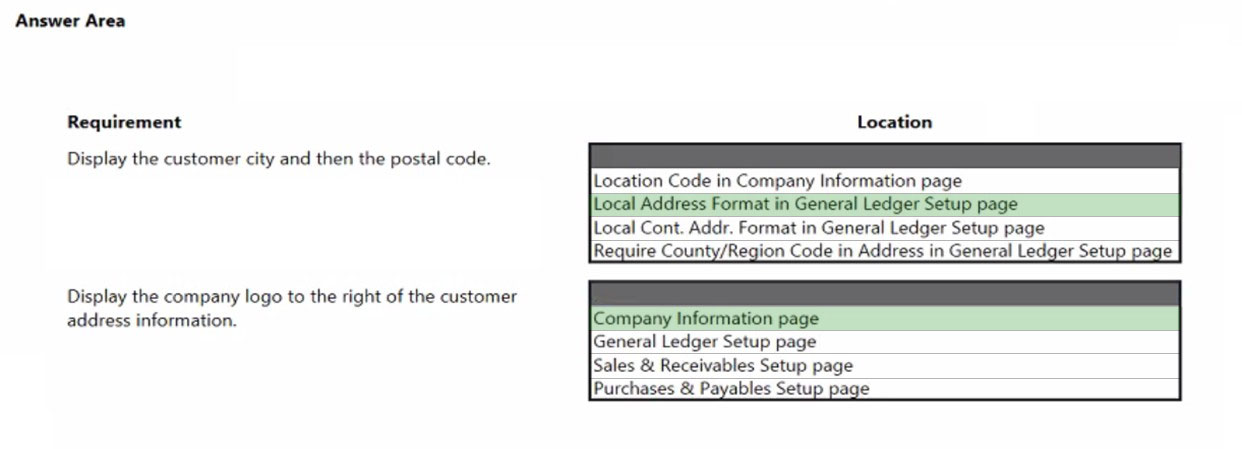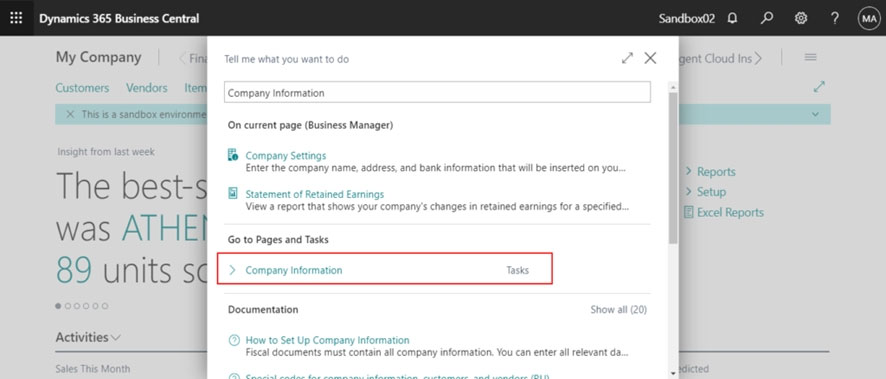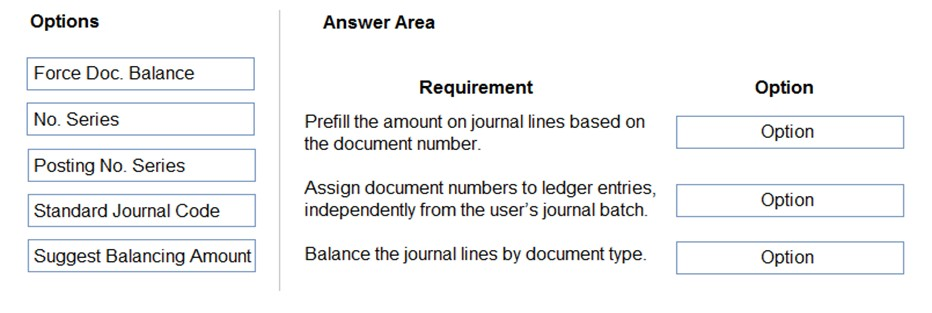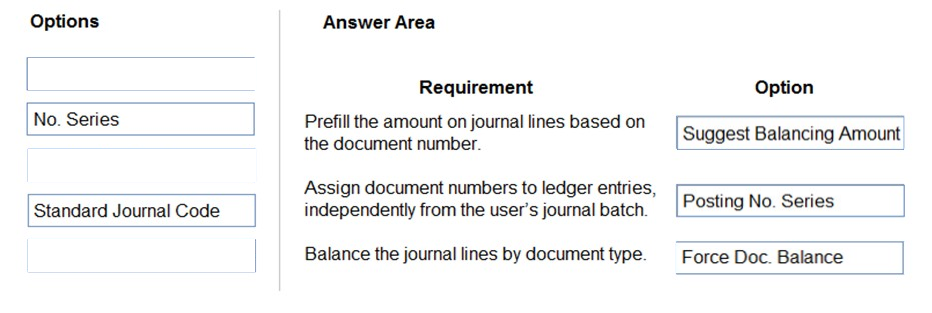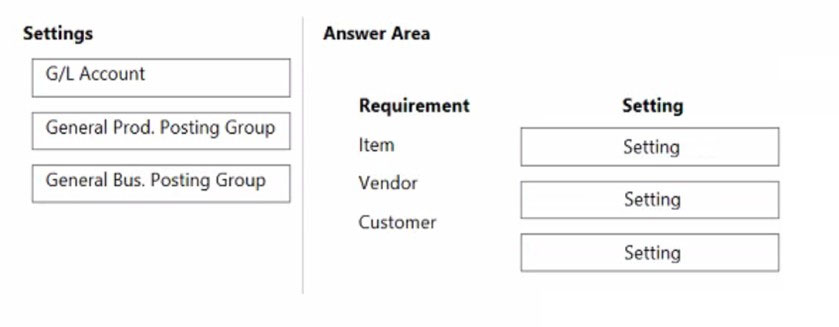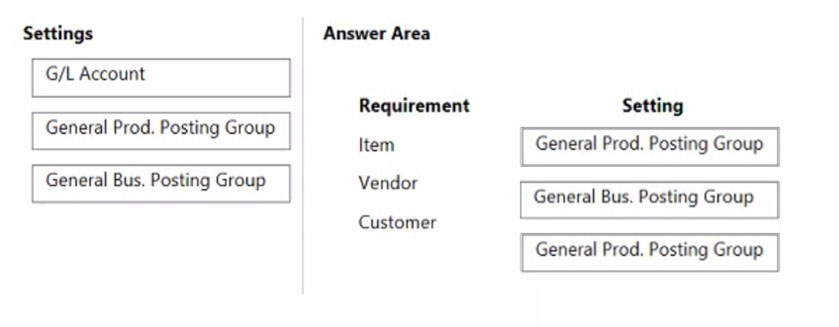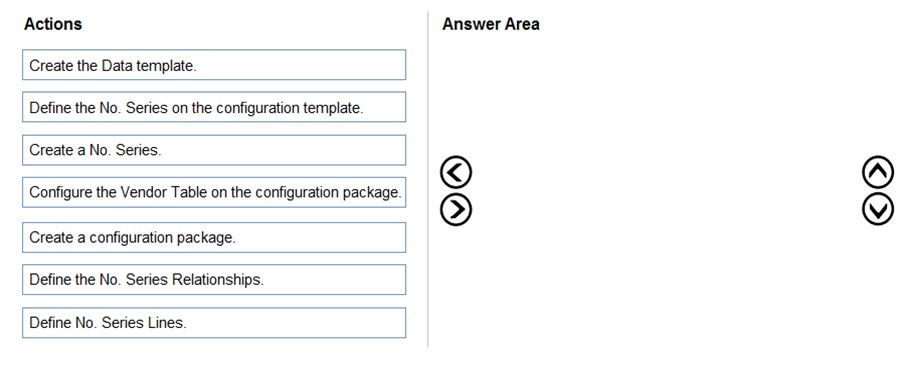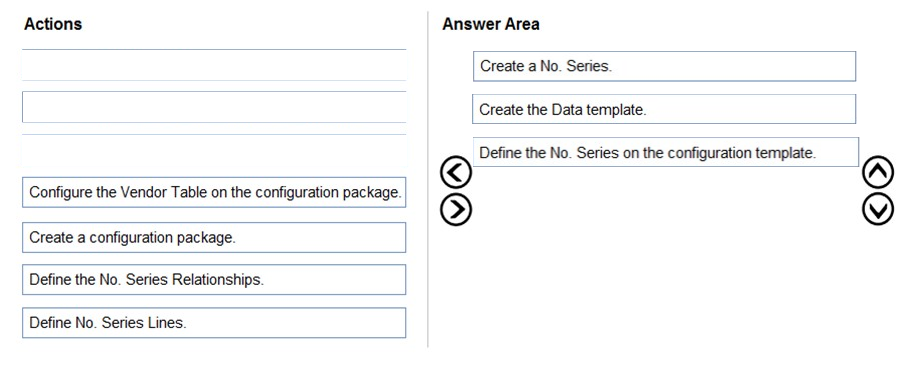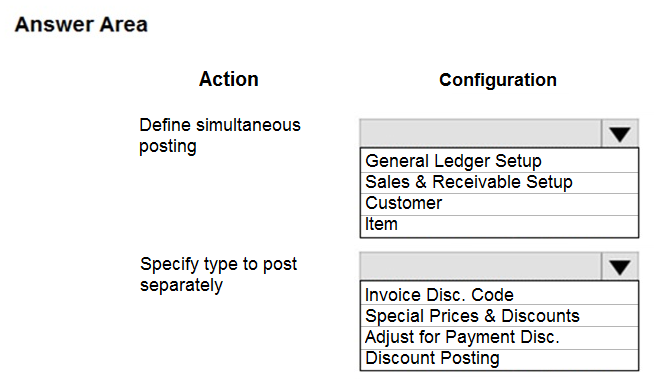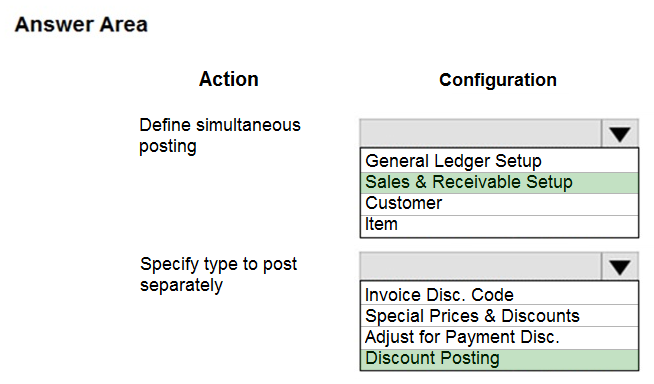MB-800 Dump Free – 50 Practice Questions to Sharpen Your Exam Readiness.
Looking for a reliable way to prepare for your MB-800 certification? Our MB-800 Dump Free includes 50 exam-style practice questions designed to reflect real test scenarios—helping you study smarter and pass with confidence.
Using an MB-800 dump free set of questions can give you an edge in your exam prep by helping you:
- Understand the format and types of questions you’ll face
- Pinpoint weak areas and focus your study efforts
- Boost your confidence with realistic question practice
Below, you will find 50 free questions from our MB-800 Dump Free collection. These cover key topics and are structured to simulate the difficulty level of the real exam, making them a valuable tool for review or final prep.
A company uses Dynamics 365 Business Central. A customer wants to sell items that are not normally counted in the company's warehouse. You need to configure the system to meet this requirement. What should you set up?
A. Non-Inventory Item type
B. Item charge
C. Inventory Item type
D. Resource
You are implementing Dynamics 365 Business Central for a company. The company often invoices multiple shipments on one invoice. You need to train the accounting staff how to process these sales invoices. In which two ways should you train the staff to create invoices? Each correct answer presents a complete solution. NOTE: Each correct selection is worth one point.
A. Use the Combine Shipments batch job to automatically create and post sales invoices and credit memos.
B. Create a new invoice for the Bill-to-Customer. Use the Get Shipment Lines action to select all the shipments from different sales orders and Sell-to-Customers.
C. Use the Combine Shipments batch job to automatically create sales invoices and delete completed sales orders.
D. Create a new invoice for the Sell-to Customer. Use the Get Shipment Lines action to select all the shipments from different sales orders, in the same currency.
E. Use the Combine Shipments batch job to automatically create, post, and print sales invoices.
HOTSPOT - A company uses Dynamics 365 Business Central to manage accounts payables. The company uses exact cost reversing when returning products to vendors. Returns use current costs at the time of the return. Exact cost reversing must be enforced manually for current orders and automatically applied to all future orders. You need to configure the system. Which configuration options should you use? To answer, select the appropriate options in the answer area. NOTE: Each correct selection is worth one point. Hot Area:
HOTSPOT - A company uses Dynamics 365 Business Central. You need to ensure that the company can bulk edit data by using the Edit in Excel feature. What should you use? To answer, select the appropriate options in the answer area. NOTE: Each correct selection is worth one point. Hot Area:
You need to configure sales invoicing. What are two possible ways to achieve this goal? Each correct answer presents a complete solution. NOTE: Each correct selection is worth one point.
A. Combine Shipments
B. Get Shipment Lines from Sales Order
C. Sales Order Shipping
D. Sales Order Invoicing
E. Get Shipment Lines from Sales Invoice
Monetary amounts for local currency must always display three decimal places. In General Ledger Setup, you need to configure the appropriate setup field with the appropriate value. What should you do?
A. Set the value of Amount Decimal Places to 3:3
B. Set the value of Unit-Amount Decimal Places to 3:3
C. Set the value of Inv. Rounding Precision to 0.001
D. Set the value of Unit-Amount Rounding Precision to 0.001
E. Set the value of Amount Rounding Precision to 0.001
A company is negotiating with a vendor for better prices on several items. The company has made late payments to the vendor in the past. You need to configure the system to help ensure that all future payments will be made on time. What should you do?
A. Set the vendor’s Priority field to 0 and create a workflow for generating vendor payments.
B. Set the vendor’s Priority field to 1 and enable the Late Payment Predictions extension.
C. Set the vendor’s Priority field to 1 and run the Suggest Vendor Payments process.
D. Set the Application Method to Apply to Oldest and run the Suggest Vendor Payments process.
E. Set the vendor’s Priority field to 0 and run the Suggest Vendor Payments process.
DRAG DROP - A client uses Dynamics 365 Business Central. The client must create a manufacturing company and a sales company in Business Central. Each company must be a separate legal entity. The client must select a costing method to use. You need to explain the effects of the different costing methods. What should you describe for each costing method? To answer, move the appropriate effect to the correct costing method. You may use each effect once, more than once, or not at all. You may need to drag the split bar between panes or scroll to view content. NOTE: Each correct selection is worth one point.
A company uses Dynamics 365 Business Central. An accountant posts bank entries at month end. The accountant must manually reconcile customer and vendor payment entries. You need to reconcile the entries. Which two pages should you use? Each correct answer presents part of the solution. NOTE: Each correct selection is worth one point.
A. Check Ledger Entries
B. Vendor Ledger Entries
C. Customer Ledger Entries
D. Bank Account Ledger Entries
A company implements Dynamics 365 Business Central. You need to create a new payment terms record to meet the following requirements: ✑ Ensure that the due date for all vendor invoices is 30 days. ✑ Grant vendors a two percent discount if an invoice is paid within 10 days. Which three actions should you perform? Each correct answer presents a part of the solution NOTE: Each correct selection is worth one point.
A. Set the value of the Discount Date Calculation field to 2D.
B. Set the value of the Discount Date Calculation field to 10D.
C. Set the value of the Discount % field to 2.
D. Set the value of the Due Date Calculation field to 30D.
E. Set the value of the Discount % field to 10.
You configure a cloud-based printer in Dynamics 365 Business Central. Purchase orders printed by users must automatically print to the cloud-based printer. You need to create a setup record for the user, report, and printer combination. On which page should you create the setup record?
A. Printer Selections
B. Printer Management
C. Report Layout Selection
D. Report Selection ג€” Purchase
E. Document Sending Profiles
HOTSPOT - A company uses Dynamics 365 Business Central. The company requires the following discount setup: • The system must calculate the discounts given on individual items that are sold. • The system must post the discounts to a specific general ledger account. You need to configure the system. Which settings should you configure? To answer, select the appropriate options in the answer area. NOTE: Each correct selection is worth one point.
You are implementing Dynamics 365 Business Central Online. Users must be added to Business Central for the first time. You need to add the users. Which action should you use?
A. Get New Users from Microsoft 365
B. Create a new entry on the User Setup page
C. Update Users from Microsoft 365
D. Import User Groups
DRAG DROP - You have a sales order with a quantity of 100 items. You need to post a shipment with a quantity of 50 items from the sales order. Which four actions should you perform in sequence? To answer, move the appropriate actions from the list of actions to the answer area and arrange them in the correct order. Select and Place:
A manufacturer uses Dynamics 365 Business Central to procure items. When the manufacturer deletes or changes purchase orders and blanket purchase orders, a record of these document changes must automatically be maintained. The configuration should not impact performance. You need to configure Business Central to automatically record the changes. Which three actions should you perform? Each correct answer presents part of the solution. NOTE: Each correct selection is worth one point.
A. Enable archiving of orders.
B. Open the Sales & Receivables Setup page.
C. Open the Purchases & Payables Setup page.
D. Activate the change log.
E. Enable archiving of blanket orders.
A company uses Dynamics 365 Business Central. An accountant must post sales services in a journal by using a predefined alphanumeric sequence. The accountant is using multiple general journal batches. You need to configure invoice numbers for the journal. Which two fields should you populate? Each correct answer presents part of the solution. NOTE: Each correct selection is worth one point.
A. Posting No. Series field in General Journal Templates
B. No. Series field in General Journal Batches
C. No. Series field in General Journal Templates
D. Posting No. Series field in General Journal Batches
DRAG DROP - Case study - This is a case study. Case studies are not timed separately. You can use as much exam time as you would like to complete each case. However, there may be additional case studies and sections on this exam. You must manage your time to ensure that you are able to complete all questions included on this exam in the time provided. To answer the questions included in a case study, you will need to reference information that is provided in the case study. Case studies might contain exhibits and other resources that provide more information about the scenario that is described in the case study. Each question is independent of the other questions in this case study. At the end of this case study, a review screen will appear. This screen allows you to review your answers and to make changes before you move to the next section of the exam. After you begin a new section, you cannot return to this section. To start the case study - To display the first question in this case study, click the Next button. Use the buttons in the left pane to explore the content of the case study before you answer the questions. Clicking these buttons displays information such as business requirements, existing environment, and problem statements. If the case study has an All Information tab, note that the information displayed is identical to the information displayed on the subsequent tabs. When you are ready to answer a question, click the Question button to return to the question. Background - Northwind Traders is an independent, family-owned business. The company distributes natural pet products in the Northwest region of the country/region. Products are purchased directly from manufacturers and distributed by using its own fleet of trucks. When the company started, deliveries were within a three-hour radius of the warehouse. Due to regional growth, current deliveries require drivers to stay overnight on some routes. The company plans to open a second warehouse to expand the region and eliminate overnights for route drivers. The company also plans to hire a second group of employees to run operations in this new location. The finance and accounting teams will remain in the original location. The company uses a third-party system for financials and order management. The finance department stated that the company’s fiscal year begins on July 1 and ends on June 30. The mm/dd/yyyy date format is used. As part of the expansion, the owner plans to upgrade to an ERP system and use Business Central to fulfill the company requirements and manage growth. Current environment - Orders - • Orders are emailed to customer service and manually keyed into the inventory system. Pricing and discounts - • Customer pricing is determined by the customer market type. Customer market types are Retail, Veterinarian, and Breeder. Each customer is associated with only one market type. • Vendors offer monthly promotions to customers by item, brand, or item category. • Invoices should show each customer’s base price, the discount amount, and the net price. Accounts payable - • The company wants to expand vendor payment options in the new system. Requirement - Customers - • The sales team must be able to do the following: o Quickly set up new customers with the proper settings based on customer type. o Identify customers by market type. Customer posting groups will be used to identify which market the customer belongs to. • Base price is determined by the customer market type. • The sales department should receive a warning when entering the order if a customer is over their credit limit. Sales - • Customer discounts are offered for specific time frames by item, brand, or product category. Discounts should be added to sales lines automatically. • Discounts must post to a unique general ledger (G/L) account. • The business needs to be able to track revenue by location, market, and product category dimensions. Locations 100 and 200 will be set as default dimensions on the two warehouse locations. Food, treats, toys, and supplies are the required product categories, which will be set as default dimensions on the item cards. Each customer card will have a default market dimension. • The sales manager wants to delete canceled orders and automatically archive them. Warehouse - • Orders will be fulfilled from two possible warehouse locations. • Product will be transferred between locations by using transfer orders. Sales invoices - • Invoices will be posted after delivery. • Invoices will be emailed to the customer. • The sales department must be able to quickly correct posted invoices for the following scenarios: o Posted invoices that have not been paid. o Posted invoices that have been paid. o Posted invoices created from sales orders. o Posted invoices not created from sales orders. Accounting - • The finance department requires that the company has 12 monthly accounting periods per fiscal year. • Finance department users must be able to reconcile the accounts receivable (AR) subledger to the G/L account at month end. • AR department users need the ability to settle and close invoices when customers take payment discounts after the payment discount date has passed. AR users should be allowed to accept or reject the payment tolerance. • Accounts payable (AP) department users must be able to pay vendors by electronic funds transfer (EFT) and use a payment journal batch named EFT to process payments. • When viewing G/L entries, the finance and accounting teams must be able to see debits and credits instead of a positive or negative amount. • The company needs to be able to track expenses by department and location. The departments are sales, operations, and administration. • AR must be able to correct cash application entries. Issues - Payment application - • Customers may have several stores that are responsible for their own orders and payments. • Occasionally, AR clerks mistakenly apply payments to the incorrect customer invoice. Invoicing - • When items are delivered, customers refuse the items for reasons such as damaged or wrong item. • After the invoices are posted, they must be corrected, which is time-consuming. Warehouse - • The sales department and warehouse managers must have visibility into products that are in the process of being transferred between locations. Accounts - • Customer accounts are difficult to view by market type. • The finance team does not have the ability to report revenue by customer type. Accounting - • AR users often find variances between the AR subledger and G/L account. • Customers often take the payment discount after the payment discount date has passed, leaving open invoices for small amounts. • The AP department is unable to pay vendors by EFT in the current system. • Finance and accounting team members have trouble validating postings when they use only the amounts field on G/L entries. • The finance department is unable to run financial reports by market. All revenue postings must reference a market. You need to configure Business Central to pay vendors as required by the AP team. Which five actions should you perform in sequence? To answer, move the appropriate actions from the list of actions to the answer area and arrange them in the correct order.
A company sells and services landscaping equipment. The company wants to calculate an item's sales unit price based on a flat profit rate of 20 percent. You need to adjust the item's unit price. What are two possible ways to achieve the goal? Each correct answer presents a complete solution. NOTE: Each correct selection is worth one point.
A. Create a sales job price list for the specific item.
B. Configure the unit price on the item card for the item.
C. Create a sales price list for the specific item.
D. Run the Adjust Item Costs/Prices batch job.
E. Configure the unit price by using the Suggest Item Price on Wksh feature.
HOTSPOT - A company uses Dynamics 365 Business Central. You are recording incoming payments from customers. You must record a payment of $500 for customer 2030 with a posting date of November 16, 2022. The payment must be recorded against bank account No. 1010 with general ledger (G/L) account No. 10100. You need to populate the cash receipt journal batch in Business Central to properly record the incoming payment to a bank account. Which value should you use? To answer, select the appropriate options in the answer area, NOTE: Each correct selection is worth one point. Hot Area:
DRAG DROP - A company uses Dynamics 365 Business Central. You group salespeople into teams and assign each team a Salesperson code. A salesperson reports that they can see the sales orders for other sales team members. You need to ensure that sales team members can only see sales orders that they create. Which four actions should you perform in sequence? To answer, move the appropriate actions from the list of actions to the answer area and arrange them in the correct order.
Case study - This is a case study. Case studies are not timed separately. You can use as much exam time as you would like to complete each case. However, there may be additional case studies and sections on this exam. You must manage your time to ensure that you are able to complete all questions included on this exam in the time provided. To answer the questions included in a case study, you will need to reference information that is provided in the case study. Case studies might contain exhibits and other resources that provide more information about the scenario that is described in the case study. Each question is independent of the other questions in this case study. At the end of this case study, a review screen will appear. This screen allows you to review your answers and to make changes before you move to the next section of the exam. After you begin a new section, you cannot return to this section. To start the case study - To display the first question in this case study, click the Next button. Use the buttons in the left pane to explore the content of the case study before you answer the questions. Clicking these buttons displays information such as business requirements, existing environment, and problem statements. If the case study has an All Information tab, note that the information displayed is identical to the information displayed on the subsequent tabs. When you are ready to answer a question, click the Question button to return to the question. Background - Northwind Traders is an independent, family-owned business. The company distributes natural pet products in the Northwest region of the country/region. Products are purchased directly from manufacturers and distributed by using its own fleet of trucks. When the company started, deliveries were within a three-hour radius of the warehouse. Due to regional growth, current deliveries require drivers to stay overnight on some routes. The company plans to open a second warehouse to expand the region and eliminate overnights for route drivers. The company also plans to hire a second group of employees to run operations in this new location. The finance and accounting teams will remain in the original location. The company uses a third-party system for financials and order management. The finance department stated that the company’s fiscal year begins on July 1 and ends on June 30. The mm/dd/yyyy date format is used. As part of the expansion, the owner plans to upgrade to an ERP system and use Business Central to fulfill the company requirements and manage growth. Current environment - Orders - • Orders are emailed to customer service and manually keyed into the inventory system. Pricing and discounts - • Customer pricing is determined by the customer market type. Customer market types are Retail, Veterinarian, and Breeder. Each customer is associated with only one market type. • Vendors offer monthly promotions to customers by item, brand, or item category. • Invoices should show each customer’s base price, the discount amount, and the net price. Accounts payable - • The company wants to expand vendor payment options in the new system. Requirement - Customers - • The sales team must be able to do the following: o Quickly set up new customers with the proper settings based on customer type. o Identify customers by market type. Customer posting groups will be used to identify which market the customer belongs to. • Base price is determined by the customer market type. • The sales department should receive a warning when entering the order if a customer is over their credit limit. Sales - • Customer discounts are offered for specific time frames by item, brand, or product category. Discounts should be added to sales lines automatically. • Discounts must post to a unique general ledger (G/L) account. • The business needs to be able to track revenue by location, market, and product category dimensions. Locations 100 and 200 will be set as default dimensions on the two warehouse locations. Food, treats, toys, and supplies are the required product categories, which will be set as default dimensions on the item cards. Each customer card will have a default market dimension. • The sales manager wants to delete canceled orders and automatically archive them. Warehouse - • Orders will be fulfilled from two possible warehouse locations. • Product will be transferred between locations by using transfer orders. Sales invoices - • Invoices will be posted after delivery. • Invoices will be emailed to the customer. • The sales department must be able to quickly correct posted invoices for the following scenarios: o Posted invoices that have not been paid. o Posted invoices that have been paid. o Posted invoices created from sales orders. o Posted invoices not created from sales orders. Accounting - • The finance department requires that the company has 12 monthly accounting periods per fiscal year. • Finance department users must be able to reconcile the accounts receivable (AR) subledger to the G/L account at month end. • AR department users need the ability to settle and close invoices when customers take payment discounts after the payment discount date has passed. AR users should be allowed to accept or reject the payment tolerance. • Accounts payable (AP) department users must be able to pay vendors by electronic funds transfer (EFT) and use a payment journal batch named EFT to process payments. • When viewing G/L entries, the finance and accounting teams must be able to see debits and credits instead of a positive or negative amount. • The company needs to be able to track expenses by department and location. The departments are sales, operations, and administration. • AR must be able to correct cash application entries. Issues - Payment application - • Customers may have several stores that are responsible for their own orders and payments. • Occasionally, AR clerks mistakenly apply payments to the incorrect customer invoice. Invoicing - • When items are delivered, customers refuse the items for reasons such as damaged or wrong item. • After the invoices are posted, they must be corrected, which is time-consuming. Warehouse - • The sales department and warehouse managers must have visibility into products that are in the process of being transferred between locations. Accounts - • Customer accounts are difficult to view by market type. • The finance team does not have the ability to report revenue by customer type. Accounting - • AR users often find variances between the AR subledger and G/L account. • Customers often take the payment discount after the payment discount date has passed, leaving open invoices for small amounts. • The AP department is unable to pay vendors by EFT in the current system. • Finance and accounting team members have trouble validating postings when they use only the amounts field on G/L entries. • The finance department is unable to run financial reports by market. All revenue postings must reference a market. You need to configure Business Central to display G/L entries as required by the accounting team. Which configuration should you use?
A. Show Amounts
B. Check G/L Account Usage
C. G/L Account Card
D. Debit/Credit
Case study - This is a case study. Case studies are not timed separately. You can use as much exam time as you would like to complete each case. However, there may be additional case studies and sections on this exam. You must manage your time to ensure that you are able to complete all questions included on this exam in the time provided. To answer the questions included in a case study, you will need to reference information that is provided in the case study. Case studies might contain exhibits and other resources that provide more information about the scenario that is described in the case study. Each question is independent of the other questions in this case study. At the end of this case study, a review screen will appear. This screen allows you to review your answers and to make changes before you move to the next section of the exam. After you begin a new section, you cannot return to this section. To start the case study - To display the first question in this case study, click the Next button. Use the buttons in the left pane to explore the content of the case study before you answer the questions. Clicking these buttons displays information such as business requirements, existing environment, and problem statements. If the case study has an All Information tab, note that the information displayed is identical to the information displayed on the subsequent tabs. When you are ready to answer a question, click the Question button to return to the question. Background - Northwind Traders is an independent, family-owned business. The company distributes natural pet products in the Northwest region of the country/region. Products are purchased directly from manufacturers and distributed by using its own fleet of trucks. When the company started, deliveries were within a three-hour radius of the warehouse. Due to regional growth, current deliveries require drivers to stay overnight on some routes. The company plans to open a second warehouse to expand the region and eliminate overnights for route drivers. The company also plans to hire a second group of employees to run operations in this new location. The finance and accounting teams will remain in the original location. The company uses a third-party system for financials and order management. The finance department stated that the company’s fiscal year begins on July 1 and ends on June 30. The mm/dd/yyyy date format is used. As part of the expansion, the owner plans to upgrade to an ERP system and use Business Central to fulfill the company requirements and manage growth. Current environment - Orders - • Orders are emailed to customer service and manually keyed into the inventory system. Pricing and discounts - • Customer pricing is determined by the customer market type. Customer market types are Retail, Veterinarian, and Breeder. Each customer is associated with only one market type. • Vendors offer monthly promotions to customers by item, brand, or item category. • Invoices should show each customer’s base price, the discount amount, and the net price. Accounts payable - • The company wants to expand vendor payment options in the new system. Requirement - Customers - • The sales team must be able to do the following: o Quickly set up new customers with the proper settings based on customer type. o Identify customers by market type. Customer posting groups will be used to identify which market the customer belongs to. • Base price is determined by the customer market type. • The sales department should receive a warning when entering the order if a customer is over their credit limit. Sales - • Customer discounts are offered for specific time frames by item, brand, or product category. Discounts should be added to sales lines automatically. • Discounts must post to a unique general ledger (G/L) account. • The business needs to be able to track revenue by location, market, and product category dimensions. Locations 100 and 200 will be set as default dimensions on the two warehouse locations. Food, treats, toys, and supplies are the required product categories, which will be set as default dimensions on the item cards. Each customer card will have a default market dimension. • The sales manager wants to delete canceled orders and automatically archive them. Warehouse - • Orders will be fulfilled from two possible warehouse locations. • Product will be transferred between locations by using transfer orders. Sales invoices - • Invoices will be posted after delivery. • Invoices will be emailed to the customer. • The sales department must be able to quickly correct posted invoices for the following scenarios: o Posted invoices that have not been paid. o Posted invoices that have been paid. o Posted invoices created from sales orders. o Posted invoices not created from sales orders. Accounting - • The finance department requires that the company has 12 monthly accounting periods per fiscal year. • Finance department users must be able to reconcile the accounts receivable (AR) subledger to the G/L account at month end. • AR department users need the ability to settle and close invoices when customers take payment discounts after the payment discount date has passed. AR users should be allowed to accept or reject the payment tolerance. • Accounts payable (AP) department users must be able to pay vendors by electronic funds transfer (EFT) and use a payment journal batch named EFT to process payments. • When viewing G/L entries, the finance and accounting teams must be able to see debits and credits instead of a positive or negative amount. • The company needs to be able to track expenses by department and location. The departments are sales, operations, and administration. • AR must be able to correct cash application entries. Issues - Payment application - • Customers may have several stores that are responsible for their own orders and payments. • Occasionally, AR clerks mistakenly apply payments to the incorrect customer invoice. Invoicing - • When items are delivered, customers refuse the items for reasons such as damaged or wrong item. • After the invoices are posted, they must be corrected, which is time-consuming. Warehouse - • The sales department and warehouse managers must have visibility into products that are in the process of being transferred between locations. Accounts - • Customer accounts are difficult to view by market type. • The finance team does not have the ability to report revenue by customer type. Accounting - • AR users often find variances between the AR subledger and G/L account. • Customers often take the payment discount after the payment discount date has passed, leaving open invoices for small amounts. • The AP department is unable to pay vendors by EFT in the current system. • Finance and accounting team members have trouble validating postings when they use only the amounts field on G/L entries. • The finance department is unable to run financial reports by market. All revenue postings must reference a market. You need to train the Accounts Receivable (AR) department how to correct customer payment application issues. What are two possible ways to achieve this? Each correct answer presents a complete solution. NOTE: Each correct selection is worth one point.
A. Unapply entries from the customer ledger entries.
B. Unapply entries from the detailed customer ledger entries.
C. Unapply entries from the customer card.
D. Apply entries from the Detailed Customer Ledger Entries page.
This is a case study. Case studies are not timed separately. You can use as much exam time as you would like to complete each case. However, there may be additional case studies and sections on this exam. You must manage your time to ensure that you are able to complete all questions included on this exam in the time provided. To answer the questions included in a case study, you will need to reference information that is provided in the case study. Case studies might contain exhibits and other resources that provide more information about the scenario that is described in the case study. Each question is independent of the other questions in this case study. At the end of this case study, a review screen will appear. This screen allows you to review your answers and to make changes before you move to the next section of the exam. After you begin a new section, you cannot return to this section. To start the case study - To display the first question in the case study, click the Next button. Use the buttons in the left pane to explore the content of the case study before you answer the questions. Clicking these buttons displays information such as business requirements, existing environment, and problem statements. When you are ready to answer a question, click the Question button to return to the question. Background - Fabrikam, Inc., is a manufacturer of products for the gift industry. The company plans to implement Business Central as its new enterprise resource planning (ERP) system. The company sells to two types of customers: wholesale and retail. Retail customers order at special events and online. Wholesale customers send in orders by email. Current Environment - Order processing - • The company uses a purchase order (PO) workflow for any PO over $500. • The system has been fully configured for sales order prepayments and will check for a prepayment invoice at posting. • Customers can special order products with a prepayment that is due on receipt. Invoicing - • Wholesale customer payment terms are net 30, with a 2% discount if paid within 10 days. • Retail customer payment terms are payable on receipt or shipment. Reporting - • The company uses headcount (number of employees) and square footage for statistical accounts. Integrations - The company currently uses Outlook, Excel, Word, and Teams to communicate internally and externally with customers and vendors. Requirements - Order processing - • The company must be able to combine multiple purchase receipts into one vendor invoice. • Posted vendor invoices must be reverted when damages are reported or a product is returned to the vendor. • Fully invoiced POs must not appear on the PO list page. • Customer prepayments vary based on customer relationship. Special orders from new customers have a 25% prepayment. Established customers have only a 15% prepayment. • The company must be able to approve POs by email without opening Business Central. • Customers often reorder the same items with similar quantities. The system must be configured to ask the user if recurring lines should be added to sales orders. Invoicing - • Customer revenue must be posted to separate general ledger (G/L) accounts based on customer type. The G/L account must have subcategories for wholesale and retail revenue. • Accounts receivable must be posted to separate G/L accounts based on customer type. The G/L account must have subcategories for wholesale and retail accounts receivable. • Currently, inventory is sold at a cost based on purchase and sales over a period. Reporting - • Financial reports must include statistical accounts. • The financial report structure must map to account categories. Integrations - The company requires the following integration capabilities: • Create sales orders while collaborating with customers by email. • Edit customer information while messaging the sales team in a group chat. • Communicate a brochure to all customers at once about a sales campaign. General ledger posting accounts - The company requires the following G/L posting accounts: • Retail Receivables = 13100 • Wholesale Receivables = 13200 • Payment Discount = 54800 • Retail Sales = 44100 • Wholesale Sales = 44200 • Sales Prepayments = 22160 Issues - • Order entry takes too long for wholesale customers. • Vendors ship partial orders but send one monthly invoice. The company is unable to associate one invoice with multiple POs in the current environment. • Inventory reconciliation was difficult in the company's old system because it allowed users to sell more inventory than was physically available. • Users must log in to the system to provide workflow approvals. You need to configure the system to post to the receivables account for wholesale customers. Which two configurations should you use? Each correct answer presents part of the solution. NOTE: Each correct selection is worth one point.
A. Receivables account 13100
B. General Posting Setup
C. Receivables account 13200
D. General Business Posting Groups
E. Customer Posting Groups
You create a test instance of Dynamics 365 Business Central and enter transactions for testing purposes. You create a production company instance in the same Business Central environment. You need to copy the setup and master data from the test instance to the production instance without copying transaction data. What are two possible ways to achieve the goal? Each correct answer presents a complete solution. NOTE: Each correct selection is worth one point.
A. Use the Run Migration Now function from Cloud Migration Management
B. Create and export a configuration package from the source company. Next, import into the destination company
C. Use the Copy Data from Company function from the Configuration Worksheet page
D. Use the Copy function from the Companies page
HOTSPOT - A company uses Dynamics 365 Business Central. You need to customize sales invoice printouts to meet the following requirements: ✑ Display the customer city and then the postal code. ✑ Display the company logo to the right of the customer address information. Where should you make the configuration change? To answer, select the appropriate options in the answer area. NOTE: Each correct selection is worth one point. Hot Area:
DRAG DROP - You are setting up the general journals and batches for an accounting department. The accounting department has multiple users who will work simultaneously within different general journals. You need to set up the different journal templates and batches for each user according to the company's requirements. Which options should you use? To answer, drag the appropriate options to the correct requirements. Each option may be used once, more than once, or not at all. You may need to drag the split bar between panes or scroll to view content. NOTE: Each correct selection is worth one point. Select and Place:
A manufacturer is implementing Dynamics 365 Business Central as a new financial system. The manufacturer requires financial reports to match reports produced by the current financial system. You need to create account categories and subcategories to align with historical financial reports. What are two possible ways to achieve this goal? Each correct answer presents part of the solution. NOTE: Each correct selection is worth one point.
A. Rename top-level account categories.
B. Create or delete account subcategories.
C. Create top-level account categories.
D. Add a subcategory to the general ledger account and update the equivalent account schedule.
DRAG DROP - A company is implementing Dynamics 365 Business Central. You need to create posting details for the master data. Which setting should you use? To answer, drag the appropriate settings to the correct requirements. Each setting may be used once, more than once, or not at all. You may need to drag the split bar between panes or scroll to view content. NOTE: Each correct selection is worth one point. Select and Place:
A company uses Dynamics 365 Business Central. The company has a customer that will also be a vendor for the company in the next financial year. The company plans to consolidate the customer and vendor balances to reduce unnecessary payments on receipts and reduce the amount of transaction fees. You need to configure the contact card. Which option should you configure first?
A. Create as Employee
B. Create as Customer
C. Create as Bank
D. Create as Vendor
You need to set up payment terms for buying groups. Which two actions should you perform? Each correct answer presents part of the solution. NOTE: Each correct selection is worth one point.
A. Set up payment terms with a value of CM+20D for the due date calculation.
B. Assign the payment terms to the customer price group.
C. Assign the payment terms to the customer.
D. Assign the payment terms to the customer posting group.
E. Set up payment terms with a value of D20 for the due date calculation.
DRAG DROP - You need to design a process to resolve the broker issues for Accounts. Which three actions should perform in sequence? To answer, move the appropriate actions from the list of actions to the answer area and arrange them in the correct order. NOTE: More than one order of answer choices is correct. You will receive credit for any of the correct orders you select. Select and Place:
A company has been using Dynamics 365 Business Central for many years. A new accounting manager for the company reviews the chart of accounts. The manager wants to remove some general ledger accounts. The Check G/L Account Usage field is selected in the General Ledger Setup. You need to assist with the account deletions. What is one requirement that enables deletion of a general ledger account?
A. The account cannot have a balance amount.
B. The account cannot be used in any account schedule.
C. The general ledger account is configured to allow for deletion
D. The account must have ledger entries.
You copy a General Posting Setup from an instance of Dynamics 365 Business Central. You must configure the General Posting Setup. You assign a category and subcategory to each account. You need to complete the configuration as efficiently as possible. What are three ways to complete the configuration? Each correct answer presents a complete solution. NOTE: Each correct selection is worth one point.
A. Use the Copy action to create a new General Posting Setup Card
B. Import a configuration package that contains the General Posting Setup
C. Use the Suggest Accounts action to create all possible posting setup combinations
D. Create a new General Posting Setup Card, and then use the Suggest Accounts action
E. Create a new General Posting Setup Card, and then use the Copy action
DRAG DROP - You are implementing Dynamics 365 Business Central. The purchasing manager wants to implement an approval system by using email notifications. You need to set up the notification system. Which setup should you use? To answer, drag the appropriate setup to the correct actions. Each setup may be used once, more than once, or not at all. You may need to drag the split bar between panes or scroll to view content. NOTE: Each correct selection is worth one point. Select and Place:
You are implementing Dynamics 365 Business Central. You are unable to view some expected functionality in the system. You need to demonstrate the use of different options for assigning profiles to users. In which three places can you assign profiles to users? Each correct answer presents a complete solution. NOTE: Each correct selection is worth one point.
A. Assign a User Group to the user. Assign the Profile to the User Group.
B. Assign a Profile on the User Personalization page.
C. Assign the Profile on the User card.
D. Accept the default Profile.
E. Add the user to the Profile card.
A company has been using Dynamics 365 Business Central for many years. A new accounting manager for the company reviews the chart of accounts. The manager wants to remove some general ledger accounts. The Check G/L Account Usage field is selected in the General Ledger Setup. You need to assist with the account deletions. What is one requirement that enables deletion of a general ledger account?
A. The account cannot be used in any account schedule.
B. The fiscal year needs to be closed.
C. The account cannot have a balance amount.
D. The account must have ledger entries.
After you answer a question in this section, you will NOT be able to return to it. As a result, these questions will not appear in the review screen. You are implementing Dynamics 365 Business Central for a company. The company provides subscription services to their customers. The subscription invoices are almost identical each month. The company wants to set up recurring sales lines for subscription invoices. You need to create systems for creating subscription invoices. Solution: Create a blanket order. Add the necessary lines to the blanket order. Create the monthly sales order. Then, create the invoice. Does the solution meet the goal?
A. Yes
B. No
You need to configure sales for the cash and carry desk. What should you select?
A. Payment Service
B. Direct Debit Mandate with a value of OneOff for Type of Payment
C. Payment Method with a value of Bank Account for Balance Account
D. Payment Terms with a value of 0D for Due Date Calculation
DRAG DROP - A company plans to set up an approval process for purchase orders in Business Central. The approval process must automatically send out an approval request as soon as a purchase order is created. Purchase orders that require approval must be for an amount of $600 or more. You need to configure the approval workflows. Which areas should you configure for each use case? To answer, drag the appropriate areas to the correct use cases. Each area may be used once, more than once, or not at all. You may need to drag the split bar between panes or scroll to view content. NOTE: Each correct selection is worth one point.
A company uses Dynamics 365 Business Central. The company wants to print financial statements by using a cloud-based printer. You need to recommend the type of printer the customer should install. Which type of printer should you recommend?
A. Email
B. System
C. Client default
D. Server default
HOTSPOT - You need to configure the sales invoices to show the discounts. How should you configure the system? To answer, select the appropriate options in the answer area. NOTE: Each correct selection is worth one point. Hot Area:
You need to configure the new customer creation process. Which two areas must you configure? Each correct answer presents part of the solution NOTE: Each correct selection is worth one point.
A. Responsibility center
B. Configuration worksheet
C. Configuration template
D. Permissions
DRAG DROP - This is a case study. Case studies are not timed separately. You can use as much exam time as you would like to complete each case. However, there may be additional case studies and sections on this exam. You must manage your time to ensure that you are able to complete all questions included on this exam in the time provided. To answer the questions included in a case study, you will need to reference information that is provided in the case study. Case studies might contain exhibits and other resources that provide more information about the scenario that is described in the case study. Each question is independent of the other questions in this case study. At the end of this case study, a review screen will appear. This screen allows you to review your answers and to make changes before you move to the next section of the exam. After you begin a new section, you cannot return to this section. To start the case study - To display the first question in the case study, click the Next button. Use the buttons in the left pane to explore the content of the case study before you answer the questions. Clicking these buttons displays information such as business requirements, existing environment, and problem statements. When you are ready to answer a question, click the Question button to return to the question. Background - Fabrikam, Inc., is a manufacturer of products for the gift industry. The company plans to implement Business Central as its new enterprise resource planning (ERP) system. The company sells to two types of customers: wholesale and retail. Retail customers order at special events and online. Wholesale customers send in orders by email. Current Environment - Order processing - • The company uses a purchase order (PO) workflow for any PO over $500. • The system has been fully configured for sales order prepayments and will check for a prepayment invoice at posting. • Customers can special order products with a prepayment that is due on receipt. Invoicing - • Wholesale customer payment terms are net 30, with a 2% discount if paid within 10 days. • Retail customer payment terms are payable on receipt or shipment. Reporting - • The company uses headcount (number of employees) and square footage for statistical accounts. Integrations - The company currently uses Outlook, Excel, Word, and Teams to communicate internally and externally with customers and vendors. Requirements - Order processing - • The company must be able to combine multiple purchase receipts into one vendor invoice. • Posted vendor invoices must be reverted when damages are reported or a product is returned to the vendor. • Fully invoiced POs must not appear on the PO list page. • Customer prepayments vary based on customer relationship. Special orders from new customers have a 25% prepayment. Established customers have only a 15% prepayment. • The company must be able to approve POs by email without opening Business Central. • Customers often reorder the same items with similar quantities. The system must be configured to ask the user if recurring lines should be added to sales orders. Invoicing - • Customer revenue must be posted to separate general ledger (G/L) accounts based on customer type. The G/L account must have subcategories for wholesale and retail revenue. • Accounts receivable must be posted to separate G/L accounts based on customer type. The G/L account must have subcategories for wholesale and retail accounts receivable. • Currently, inventory is sold at a cost based on purchase and sales over a period. Reporting - • Financial reports must include statistical accounts. • The financial report structure must map to account categories. Integrations - The company requires the following integration capabilities: • Create sales orders while collaborating with customers by email. • Edit customer information while messaging the sales team in a group chat. • Communicate a brochure to all customers at once about a sales campaign. General ledger posting accounts The company requires the following G/L posting accounts: • Retail Receivables = 13100 • Wholesale Receivables = 13200 • Payment Discount = 54800 • Retail Sales = 44100 • Wholesale Sales = 44200 • Sales Prepayments = 22160 Issues - • Order entry takes too long for wholesale customers. • Vendors ship partial orders but send one monthly invoice. The company is unable to associate one invoice with multiple POs in the current environment. • Inventory reconciliation was difficult in the company's old system because it allowed users to sell more inventory than was physically available. • Users must log in to the system to provide workflow approvals. You need to resolve the order entry issue. How should you complete each action? To answer, move the appropriate recurring sales line configurations to the correct actions. You may use each recurring sales line configuration once, more than once, or not at all. You may need to move the split bar between panes or scroll to view content. NOTE: Each correct selection is worth one point.
DRAG DROP - A company uses Dynamics 365 Business Central. The finance manager requires distinct processes for posting sales, purchase invoices, and shipments. You need to configure the restrictions. Which invoice posting policy should you use? To answer, move the appropriate invoice posting policies to the correct requirements. You may use each requirement once, more than once, or not at all. You may need to move the split bar between panes or scroll to view content. NOTE: Each correct selection is worth one point.
A company uses Dynamics 365 Business Central for their receivables. The company wants to mark any automatically matched payments to open invoices as not requiring a review if they match the highest degree of confidence that the two transactions are a match. You need to configure payment matching rules. Which three criteria should you configure? Each correct answer presents part of the solution. NOTE: Each correct selection is worth one point.
A. Statement amount
B. Account number
C. Related-party fields
D. Transaction date
E. Transaction text
DRAG DROP - You are performing actions on posted sales invoices. You need to correct any identified errors. Which actions should you perform? To answer, drag the action buttons to the correct requirements. Each action button may be used once, or not at all. You may need to drag the split bar between panes or scroll to view content. NOTE: Each correct selection is worth one point. Select and Place:
DRAG DROP - A company uses Dynamics 365 Business Central. The company plans to automatically create vendor payments based on posted purchase invoices. The payments should be summarized based on the vendor invoices. You need to configure the vendor payments. Which three actions should you perform in sequence? To answer, move the appropriate actions from the list of actions to the answer area and arrange them in the correct order.
A company purchases items by using cash. You register a vendor payment when you a post a purchase invoice for a cash vendor. You are creating a new cash vendor. No prior vendors have been set up as cash vendors. You need to set up the vendor so that payments post automatically when you post a purchase invoice. Which type of setup should you use?
A. Payment Method as Cash
B. Payment Term as COD
C. Payment Method as Cash with balancing account
D. Prepayment
DRAG DROP - You set up a new company for a client. The client provides you with a Microsoft Excel file that contains master data for vendors and vendor bank accounts details. You need to import vendor master data and relevant bank account details by using a configuration package. Which four actions should you perform in sequence? To answer, move the appropriate actions from the list of actions to the answer area and arrange them in the correct order.
DRAG DROP - You need to undo an incorrectly posted purchase receipt from a related purchase order. Which four actions should you perform in sequence? To answer, move the appropriate actions from the list of actions to the answer area and arrange them in the correct order. Select and Place:
Access Full MB-800 Dump Free
Looking for even more practice questions? Click here to access the complete MB-800 Dump Free collection, offering hundreds of questions across all exam objectives.
We regularly update our content to ensure accuracy and relevance—so be sure to check back for new material.
Begin your certification journey today with our MB-800 dump free questions — and get one step closer to exam success!


